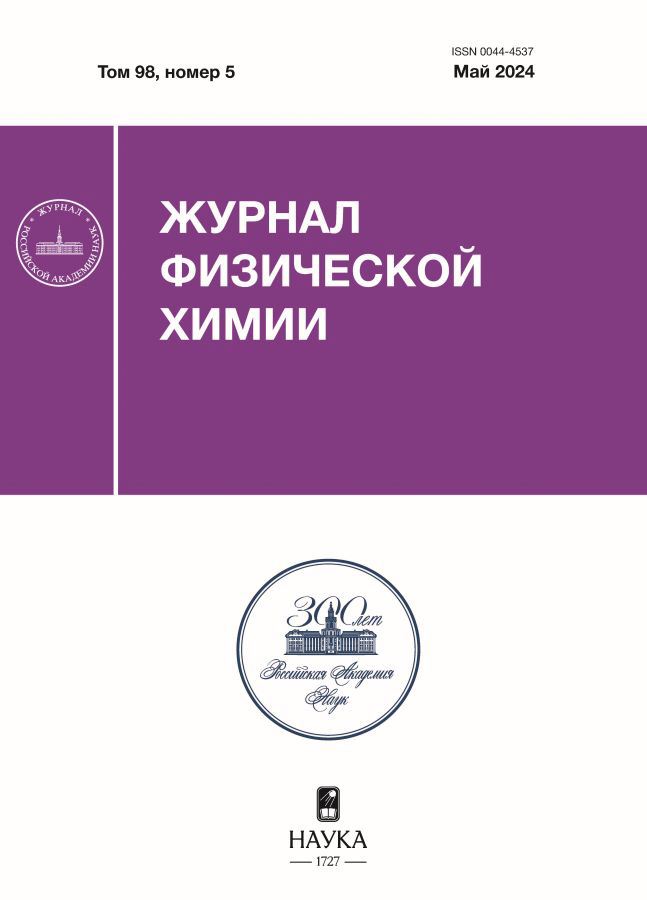Исследование спектра ионизации 6,6-диметил-фульвена методами алгебраического диаграммного построения и связанных кластеров
- Авторлар: Трофимов А.Б.1,2, Скитневская А.Д.1, Белоголова А.М.1,2, Якимова Э.К.1, Громов Е.В.1
-
Мекемелер:
- ФГБОУ ВО Иркутский государственный университет
- ФГБУН Иркутский институт химии им. А. Е. Фаворского СО РАН
- Шығарылым: Том 98, № 5 (2024)
- Беттер: 70-77
- Бөлім: ВЫЧИСЛИТЕЛЬНАЯ И КВАНТОВАЯ ХИМИЯ
- ##submission.dateSubmitted##: 27.02.2025
- ##submission.datePublished##: 29.12.2024
- URL: https://freezetech.ru/0044-4537/article/view/668985
- DOI: https://doi.org/10.31857/S0044453724050094
- EDN: https://elibrary.ru/PJWUHG
- ID: 668985
Дәйексөз келтіру
Аннотация
Электронная структура и спектр ионизации 6,6-диметил-фульвена рассчитаны с использованием метода алгебраического диаграммного построения третьего порядка для одночастичной функции Грина (IP-ADC(3)) и метода уравнений движения для связанных кластеров в приближении модели однократных и двукратных возбуждений (IP-EOM-CCSD). Результаты использованы для интерпретации недавно полученного фотоэлектронного спектра 6,6-диметил-фульвена [M. H. Palmer et. al, Chem. Phys. Lett. 2022, 796, 139558]. Предложен ряд новых отнесений, среди которых наиболее значимым является отнесение ранее неотнесенного плеча третьей фотоэлектронной полосы в районе 10.5 эВ, которое согласно нашим IP-ADC(3)-расчетам, образовано сателлитными переходами, связанными с p-орбиталями фульвенового кольца 2a2 и 2b1. Полученные в работе данные также позволяют полагать, что у метода IP-EOM-CCSD и эквивалентных ему подходов имеются трудности с корректным описанием сателлитных состояний.
Негізгі сөздер
Толық мәтін
Авторлар туралы
А. Трофимов
ФГБОУ ВО Иркутский государственный университет; ФГБУН Иркутский институт химии им. А. Е. Фаворского СО РАН
Хат алмасуға жауапты Автор.
Email: abtrof@mail.ru
Ресей, 664003 Иркутск; 664033 Иркутск
А. Скитневская
ФГБОУ ВО Иркутский государственный университет
Email: abtrof@mail.ru
Ресей, 664003 Иркутск
А. Белоголова
ФГБОУ ВО Иркутский государственный университет; ФГБУН Иркутский институт химии им. А. Е. Фаворского СО РАН
Email: abtrof@mail.ru
Ресей, 664003 Иркутск; 664033 Иркутск
Э. Якимова
ФГБОУ ВО Иркутский государственный университет
Email: abtrof@mail.ru
Ресей, 664003 Иркутск
Е. Громов
ФГБОУ ВО Иркутский государственный университет
Email: abtrof@mail.ru
Ресей, 664003 Иркутск
Әдебиет тізімі
- Preethalayam P., Krishnan K.S., Thulasi S. и др. // Chem. Rev. 2017. Т. 117. № 5. С. 3930. https://doi.org/10.1021/acs.chemrev.6b00210
- Swan E., Platts K., Blencowe A. // Beilstein J. Org. Chem. 2019. Т. 15. С. 2113. https://doi.org/10.3762/bjoc.15.209
- Martin-Somer A., Xue X.-S., Jamieson C.S. и др. // J. Am. Chem. Soc. 2023. Т. 145. № 7. С. 4221. https://doi.org/10.1021/jacs.2c12871
- Lindner M.M., Alachraf M.W., Mitschke B. и др. // Angew. Chemie Int. Ed. 2023. Т. 62. № 35. C. e202303119. https://doi.org/10.1002/anie.202303119
- Scott A.P., Agranat I., Biedermann P.U. и др. // J. Org. Chem. 1997. Т. 62. № 7. С. 2026. https://doi.org/10.1021/jo962407l
- Replogle E.S., Trucks G.W., Staley S.W. // J. Phys. Chem. 1991. Т. 95. № 18. С. 6908. https://doi.org/10.1021/j100171a031
- Gleiter R., Heilbronner E., Meijere A. de. // Helv. Chim. Acta. 1971. Т. 54. № 4. С. 1029. https://doi.org/10.1002/hlca.19710540409
- Palmer M.H., Coreno M., De Simone M. и др. // Chem. Phys. Lett. 2022. Т. 796. С. 139558. https://doi.org/10.1016/j.cplett.2022.139558
- Cederbaum L.S., Domcke W., Schirmer J., Von Niessen W. Adv. Chem. Phys. / Eds. I. Prigogine, S.A. Rice., Wiley Online Library. 1986. Т. LXV. С. 115. https://doi.org/10.1002/9780470142899.ch3
- Nakatsuji H., Hirao K. // J. Chem. Phys. 1978. Т. 68. № 5. С. 2053. https://doi.org/10.1063/1.436028
- Nakatsuji H. // Chem. Phys. Lett. 1979. Т. 67. № 2–3. С. 334. https://doi.org/10.1016/0009-2614(79)85173-8
- Ehara M., Hasegawa J., Nakatsuji H. // Theory and Applications of Computational Chemistry.: Elsevier, 2005. С. 1099. https://doi.org/10.1016/B978-044451719-7/50082-2
- Schirmer J., Cederbaum L.S., Walter O. // Phys. Rev. A. 1983. Т. 28. № 3. С. 1237. https://doi.org/10.1103/PhysRevA.28.1237
- Schirmer J., Trofimov A.B., Stelter G. // J. Chem. Phys. 1998. Т. 109. № 12. С. 4734. https://doi.org/10.1063/1.477085
- Dempwolff A.L., Paul A.C., Belogolova A.M. и др. // Ibid. 2020. Т. 152. № 2. С. 024113. https://doi.org/10.1063/1.5137792
- Patanen M., Abid A.R., Pratt S.T. и др. // Ibid. 2021. Т. 155. № 5. С. 054304. https://doi.org/10.1063/5.0058983
- Trofimov A.B., Holland D.M.P., Powis I. и др. // Ibid. 2017. Т. 146. № 24. С. 244307. https://doi.org/10.1063/1.4986405
- Nooijen M., Bartlett R.J. // Ibid. 1995. Т. 102. № 9. С. 3629. https://doi.org/10.1063/1.468592
- Sinha D., Mukhopadhya D., Chaudhuri R. и др. // Chem. Phys. Lett. 1989. Т. 154. № 6. С. 544. https://doi.org/10.1016/0009-2614(89)87149-0
- Stanton J.F., Gauss J. // J. Chem. Phys. 1994. Т. 101. № 10. С. 8938. https://doi.org/10.1063/1.468022
- Dunning T.H. // Ibid. 1989. Т. 90. № 2. С. 1007. https://doi.org/10.1063/1.456153
- Kendall R.A., Dunning T.H., Harrison R.J. // Ibid. 1992. Т. 96. № 9. С. 6796. https://doi.org/10.1063/1.462569
- Shao Y., Gan Z., Epifanovsky E. et al. // Mol. Phys. 2015. Т. 113. № 2. С. 184. https://doi.org/10.1080/00268976.2014.952696
- Frisch M.J., Trucks G.W., Schlegel H.B., Scuseria G.E., Robb M.A., Cheeseman J.R., Scalmani G., Barone V., Petersson G.A., Nakatsuji H., X. Li, Caricato M., Marenich A.V., Bloino J., Janesko B.G., Gomperts R., Mennucci B., Hratchian H.P., Ortiz J.V., Izmaylov A.F., Sonnenberg J.L., Williams-Young D., Ding F., Lipparini F., Egidi F., Goings J., Peng B., Petrone A., Henderson T., Ranasinghe D., Zakrzewski V.G., Gao J., Rega N., Zheng G., Liang W., Hada M., Ehara M., Toyota K., Fukuda R., Hasegawa J., Ishida M., Nakajima T., Honda Y., Kitao O., Nakai H., Vreven T., Throssell K., J. Montgomery J.A., Peralta J.E., Ogliaro F., Bearpark M., Heyd J.J., Brothers E., Kudin K.N., Staroverov V.N., Keith T.A., Kobayashi R., Normand J., Raghavachari K., Rendell A., Burant J.C., Iyengar S.S., Tomasi J., Cossi M., Millam J.M., Klene M., Adamo C., Cammi R., Ochterski J.W., Martin R.L., Morokuma K., Farkas O., Foresman J.B., Fox D.J. Gaussian 16 Revision A.03, Gaussian, Inc., Wallingford, CT, 2016
- Schaftenaar G., Vlieg E., Vriend G. // J. Comput. Aided. Mol. Des. 2017. Т. 31. № 9. С. 789. https://doi.org/10.1007/s10822-017-0042-5
- Swiderek P., Michaud M., Sanche L. // J. Chem. Phys. 1995. Т. 103. № 19. С. 8424. https://doi.org/10.1063/1.470153
- Asmis K.R., Allan M., Schafer O. et al. // J. Phys. Chem. A. 1997. Т. 101. № 11. С. 2089. https://doi.org/10.1021/jp963129x
- Trofimov A., Schirmer J., Holland D.M. P. et al. // Chem. Phys. 2001. Т. 263. № 1. С. 167. https://doi.org/10.1016/S0301-0104(00)00334-7
Қосымша файлдар


























